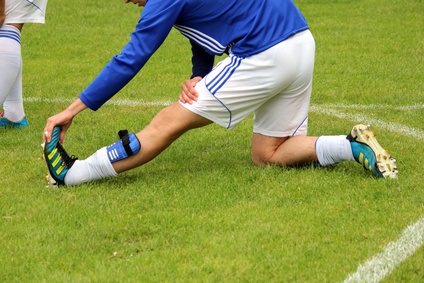Players are advised to complete a warm-up routine before they play a full football match or before they take part in any intensive training exercise. Warming-up properly can help to reduce the risk of common football injuries because warming-up prepares the body for more intensive forms of exercise.
The Benefits of Warming-up
Warming-up properly helps to improve the body’s efficiency levels and helps to improve flexibility.
Raising the temperature of the limbs by between 1 and 2 degrees Celsius can help to make the muscles and tendons more extensible. This means that they are able to move more easily and they will have greater natural limits than cold muscles and tendons do. This helps to reduce the likelihood of picking up muscle strains during the exercise.
There is also increased blood and oxygen flow to the muscle tissue. The blood helps to carry vital nutrients and anti-oxidants around the body, so increasing the blood flow means that these can be transported more easily to where they are needed in the body.
Increasing the temperature of the body also causes a rise in metabolic activity and enzyme production which helps to improve the efficiency of vital muscle contractions. Certain pre-match warm-up activities can also help to activate neural pathways. This should help to speed up the player’s reaction times.
On another level, warming-up also helps to prepare players on a psychological level. Going through the motions with steady warm-up exercises allows players to get themselves into the right frame of mind before a match. Being mentally prepared for a game can make the difference between winning and losing.
Getting started
A good video to help you get started with warming-up exercises is shown below. They may have funny accents and call it soccer but they have even more good videos if you look through their youtube channel.
Pre-Match Warm-Up Suggestion
The team should begin their warm-up routine about 30 minutes before the match is due to start. This will give them time to cover various different disciplines as part of the warm-up.
The first stage of the warm-up should be a light form of aerobic exercise, such as jogging. Starting with a light jog and building up towards running at three-quarter pace will help to gradually raise the heart rate without putting too much stress on cold muscles.
Once the heart rate has been raised and the body temperature has started to rise, it will be time to start stretching out the vital muscles. Players are advised to stretch; thigh muscles, hamstrings, Achilles, gluteal, groin, abdominal muscles, shoulders, back, pectoral muscles, biceps, trunk, stomach, calf, and hip flexor muscles. There should be a little resistance when doing these stretches, but players should not stretch so much that it hurts.
After doing static stretches, players may want to try doing some mimicry stretches. These movements mimic the most common movements that the player is likely to perform during the game. A football or other prop should not be used during mimicry stretches.
Mimicry stretches help to strengthen neural pathways in the player, so that their reaction times will be improved during play.
The final stage of the warm-up should involve functional activities and should use props like a football.
These activities should be light versions of what is expected during the course of the game. They will help to prepare the player for the game but they will not waste too much energy.
The player may use the last few minutes before kick-off to rehydrate and take on valuable nutrients for the game. The players should also know where their water bottles or sports drinks are, so that they are able to rehydrate sufficiently during the course of the match.
Half-Time
During half-time, the player must take care to balance a short period of recovery with the need to prevent their muscles from cooling down. Although the level of physical exertion which is required during the first half of a football match can help to keep the muscles warm for at least 45 minutes, the player should be aware of any conditions which may decrease the muscle temperature.
It is most important that players take on hydration and nutrition during this period. Most players will go through a miniature warm-up routine about 3 or 4 minutes before the second half kicks-off. This warm-up routine can help to reduce the likelihood of injuries occurring during the second half of the match.
